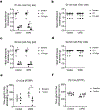Optogenetic Activation of Dopamine Receptor D1 and D2 Neurons in Anterior Cingulate Cortex Differentially Modulates Trigeminal Neuropathic Pain
- PMID: 32654077
- PMCID: PMC7484249
- DOI: 10.1007/s12035-020-02020-2
Optogenetic Activation of Dopamine Receptor D1 and D2 Neurons in Anterior Cingulate Cortex Differentially Modulates Trigeminal Neuropathic Pain
Abstract
Anterior cingulate cortex (ACC) is a critical brain center for chronic pain processing. Dopamine signaling in the brain has been demonstrated to contribute to descending pain modulation. However, the role of ACC dopamine receptors in chronic neuropathic pain remains unclear. In this study, we investigated the effect of optogenetic activation of ACC dopamine receptors D1- and D2-expressing neurons on trigeminal neuropathic pain. Chronic constriction injury of infraorbital nerve (CCI-ION) was carried out to induce trigeminal neuropathic pain in mice. We conducted optogenetic stimulation to specifically activate D1- and D2-expressing neurons in the ACC. Western blotting and immunofluorescence staining were used to examine ACC D1 and D2 expression and localization. The von Frey and real-time place preference tests were performed to measure evoked mechanical pain and nonreflexive emotional pain behaviors, respectively. We observed that dopamine receptors D1 and D2 in the ACC are primarily expressed in excitatory neurons and that the D2 receptor is differentially regulated in the early and late phases of trigeminal neuropathic pain. Optogenetic activation of D1-expressing neurons in the ACC markedly exacerbates CCI-ION-induced trigeminal neuropathic pain in both early and late phases, but optogenetic activation of D2-expressing neurons in the ACC robustly ameliorates such pain in its late phase. Our results suggest that dopamine receptors D1 and D2 in the ACC play different roles in the modulation of trigeminal neuropathic pain.
Keywords: Anterior cingulate cortex; Dopamine receptors; Optogenetic stimulation; Trigeminal neuropathic pain.
Conflict of interest statement
CONFLICT OF INTEREST
The authors have no conflict of interest to declare.
Figures




Similar articles
-
Dopamine receptor D2, but not D1, mediates descending dopaminergic pathway-produced analgesic effect in a trigeminal neuropathic pain mouse model.Pain. 2019 Feb;160(2):334-344. doi: 10.1097/j.pain.0000000000001414. Pain. 2019. PMID: 30325872 Free PMC article.
-
Suppression of mechanical hypersensitivity and change in the expression of the dopamine D2 receptor by administration of anti-CGRP antibody into the trigeminal ganglion in trigeminal neuropathic pain model rats.PLoS One. 2025 May 14;20(5):e0323810. doi: 10.1371/journal.pone.0323810. eCollection 2025. PLoS One. 2025. PMID: 40367052 Free PMC article.
-
Expression of the dopaminergic D1 and D2 receptors in the anterior cingulate cortex in a model of neuropathic pain.Mol Pain. 2011 Dec 15;7:97. doi: 10.1186/1744-8069-7-97. Mol Pain. 2011. PMID: 22171983 Free PMC article.
-
Optogenetic Stimulation of the Anterior Cingulate Cortex Modulates the Pain Processing in Neuropathic Pain: A Review.J Mol Neurosci. 2022 Jan;72(1):1-8. doi: 10.1007/s12031-021-01898-4. Epub 2021 Sep 10. J Mol Neurosci. 2022. PMID: 34505976 Review.
-
A novel dopamine receptor signaling unit in brain: heterooligomers of D1 and D2 dopamine receptors.ScientificWorldJournal. 2007 Nov 2;7:58-63. doi: 10.1100/tsw.2007.223. ScientificWorldJournal. 2007. PMID: 17982577 Free PMC article. Review.
Cited by
-
Dopamine D2 Receptor Activation Blocks GluA2/ROS Positive Feedback Loop to Alienate Chronic-Migraine-Associated Pain Sensitization.Antioxidants (Basel). 2024 Jun 14;13(6):725. doi: 10.3390/antiox13060725. Antioxidants (Basel). 2024. PMID: 38929165 Free PMC article.
-
Optogenetics in oral and craniofacial research.J Zhejiang Univ Sci B. 2024 Aug 15;25(8):656-671. doi: 10.1631/jzus.B2300322. J Zhejiang Univ Sci B. 2024. PMID: 39155779 Free PMC article. Review.
-
Gut-Brain Crosstalk and the Central Mechanisms of Orofacial Pain.Brain Sci. 2023 Oct 13;13(10):1456. doi: 10.3390/brainsci13101456. Brain Sci. 2023. PMID: 37891825 Free PMC article. Review.
-
A female-specific role for trigeminal dynorphin in orofacial pain comorbidity.Pain. 2023 Dec 1;164(12):2801-2811. doi: 10.1097/j.pain.0000000000002980. Epub 2023 Jul 18. Pain. 2023. PMID: 37463238 Free PMC article.
-
Brain nuclei and neural circuits in neuropathic pain and brain modulation mechanisms of acupuncture: a review on animal-based experimental research.Front Neurosci. 2023 Aug 30;17:1243231. doi: 10.3389/fnins.2023.1243231. eCollection 2023. Front Neurosci. 2023. PMID: 37712096 Free PMC article. Review.
References
MeSH terms
Substances
Grants and funding
LinkOut - more resources
Full Text Sources

